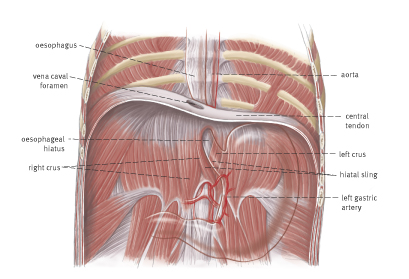1.2.3 The diaphragm
The diaphragm is a muscular plate that separates the chest and abdominal cavities from each other. It is secured to the breast bone (sternum), rib cage and lumbar spine, projecting into the chest cavity in the form of two domes. In addition to a number of smaller gaps, the diaphragm has three large openings: oesophageal hiatus for the oesophagus (gullet), aortic hiatus for the aorta (the main blood vessel in the body) and, finally, the opening for the inferior vena cava. These natural openings are potential sources of hernias through which, in the event of disease, organs or structures can be displaced from the abdominal cavity into the chest. Hernias passing through the oesophageal hiatus are also called hiatal hernias. [Fig. 3]

Fig. 3: The anatomy of the diaphragm
